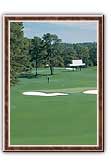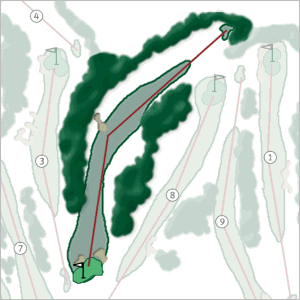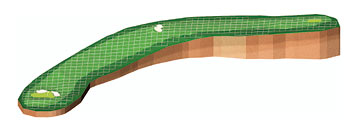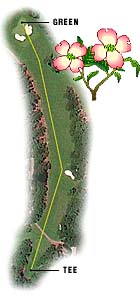| Hole Names | |
|
|
|

Hole #2Pink DogwoodCornus florida rubra Par 5, 575 Yards |

|
||
|
A dogleg left which is often reachable in two. Large, deep greenside bunkers take special attention on the second shot. Tee moved back about 25 yards, bringing the fairway bunker on the right into play. Not many will be able to catch the sharp slope in the fairway for extra distance that will make the green reachable in two. Two bunkers in front of the green. Bends to the left, only reachable in two by the longest hitters because of the new box that added 25 yards. Bunker to the left comes into play, meaning most players will use 3-wood. Two bunkers in front of the green. The longest of the National's par 5 holes. The danger is in avoiding the fairway bunker on the tee shot to the point of venturing into the sharp dropoff into the trees at the left on the inside of the dog-legged fairway. | |||

QuickTime AVI (4.79M) Animated GIF | |||
|
Jack Nicklaus says: It's a difficult hole in trying to figure out what you're going to do with your tee shot. You want to play it down the left side, but not too far down the left side because you're standing on your head to play your second shot. You want to just miss the bunker if you can, though it's 265 yards from the back of the tee. ... Once it gets running down the hill, the ball will run forever. Most people are playing a long iron or a wood into the green. It should be a birdie hole for most people. Iíve played this hole for 40 years and still havenít figured it out. You face a very difficult tee shot to a crowned fairway. Since this hole was lengthened by approximately 20 yards for the 1999 Masters, even the big hitters have to rethink their strategy a bit. The fairway bunker is at about 300 yards, so the best drive is just left of the bunker. The problem is that this leaves you an awkward second shot from a downhill, sidehill lie. You have to draw the ball around the trees and into a green that best receives a fade. This hole can give up a lot of birdies because players can put their second shot right of the green or just short and then pitch it close enough for a birdie chance. The real big hitters get it close enough where they can play a middle iron into the green. When I shot my 64 in 1965, I drove it in the right trees. I then hit it down short of the green and put it in there about eight feet behind the hole with almost a full wedge. The birdie putt helped get my round started. If youíre not careful, you can leave yourself a very long first putt here. Nick Faldo sank an incredible 100-footer (third round, 1989) on the way to his first of three green jackets. Fuzzy Zoeller says: This is a hole where he have to decide whether to challenge it or lay up. Players will hit a 2 or 3 iron or 4 or 5 wood with their second shot. The green is well-bunkered in front, but the key is to stay in front of the flag. This green is very fast if you get above the hole. Tiger Woods says: For me, I just hit driver right over the right bunker and try and leave myself with anywhere between a 3-iron and 9-iron, depending on how good I'm swinging it, and the wind. For the shorter hitters, it's one of the more difficult drives. Anything left is where Claude Harmon used to say is the Delta ticket counter, where you pick up your ticket to go home after you miss the cut. If you go for it in two, you have two fingers to hit to, in the back left, and a finger on the right. Anything on that green in two is good. The majority you'll see try and put the ball in the bunkers, because they're uphill shots and you can control the spin and hopefully get a 4. Fred Couples says: For me, I've always had trouble here. There's a bunker on the right and you have to draw the ball. Again, I just try to swing hard and hit it. A lot of times, I leave it to the right and it doesn't carry the bunker. When that happens, you have to lay up. If you do hit a good drive, you can hit 3-iron through 7-iron to the green, then it's basically very birdie-able from there. Bernhard Langer says: After my opening bogey in the 1993 final, I bounced back with a birdie on the second hole to regain my four-stroke lead. I've never found it easy to make a birdie here because I don't have the distance of Tiger Woods, Ernie Els or any of the other big hitters. For me, it's actually pretty hard to hit this green in two. I've never flown the fairway bunker. I always aim for the gap left of the bunker. Now that the Masters has moved the tee back about 20 yards, the big hitters may have to change tactics. The extra distance will definitely make them play into that gap or short of the bunker. The one place players don't want to go is left, because the ball will run down into a tiny creek in the trees. I triple-bogeyed from there in 1992. The green slopes severely, so depending on the hole location, I generally go for the opposite side on my second shot. That gives me more green to work with, especially if I land in a greenside bunker. I'd rather be in the sand or a full 90 yards away than have to face a 40- to 50-yard approach shot. This hole played the second easiest last year, so players need to make two or three birdies here.
| |||

Hole #2Pink DogwoodCornus florida rubra Cornus florida, var. ruba, is an American contribution to the world of ornamental horticulture. This tree is a mutation which is propagated by grafting onto a white dogwood seedling. Depending on weather, the tree blooms late March through April. This hole is flanked by masses of these colorful native trees. |

|
||
fatpat Software · PO Box 1785 · Charlottesville, VA 22902 · (804) 977-1652
